
Olympia is the capital of the U.S. state of Washington and the county seat and most populous city of Thurston County. It is 60 miles (100 km) southwest of the state's most populous city, Seattle, and is a cultural center of the southern Puget Sound region.
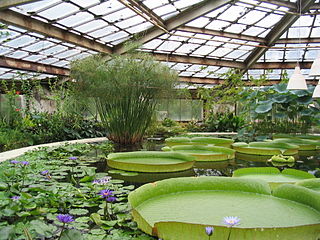
A greenhouse is a structure that allows people to regulate climatic conditions, such as temperature and humidity. There are many different designs of greenhouses; however, in general these buildings include large areas of transparent material to capture the light and heat of the sun. The three most common transparent materials used in the roof and walls of modern greenhouses are rigid plastics made of polycarbonate, plastic films made of polyethylene or glass panes. When the interior of a greenhouse is exposed to sunlight, the internal temperature rises and shelters the plants from cold weather.

Volunteer Park is a 48.3-acre (19.5 ha) park in the Capitol Hill neighborhood of Seattle, Washington, United States.

The United States Botanic Garden (USBG) is a botanical garden on the grounds of the United States Capitol in Washington, D.C., near the James A. Garfield Monument.
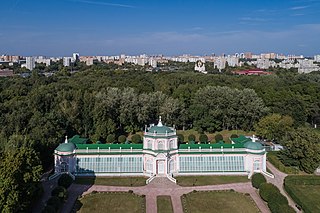
An orangery or orangerie was a room or a dedicated building on the grounds of fashionable residences of Northern Europe from the 17th to the 19th centuries where orange and other fruit trees were protected during the winter, as a very large form of greenhouse or conservatory.
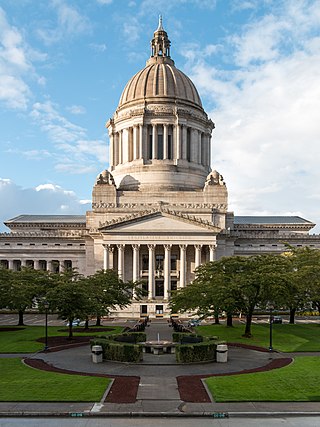
The Washington State Capitol or Legislative Building in Olympia is the home of the government of the state of Washington. It contains chambers for the Washington State Legislature and offices for the governor, lieutenant governor, secretary of state and treasurer and is part of a campus consisting of several buildings. Buildings for the Washington Supreme Court, executive agencies and the Washington Governor's Mansion are part of the capitol campus.

John Charles Olmsted was an American landscape architect. The nephew and adopted son of Frederick Law Olmsted, he worked with his father and his younger brother, Frederick Law Olmsted Jr., in their father's firm. After their father retired, the brothers took over leadership and founded Olmsted Brothers as a landscape design firm. The firm became well known for designing many urban parks, college campuses, and other public places. John Olmsted's body of work from over 40 years as a landscape architect has left its mark on the American urban landscape.
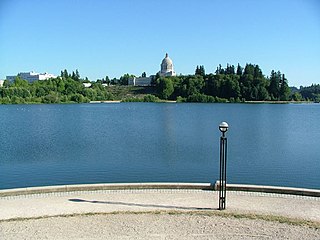
Capitol Lake is a 3 kilometer long, 260-acre (1.1 km2) artificial lake at the mouth of Deschutes River in Tumwater/Olympia, Washington. The Olympia Brewery sits on Capitol Lake in Tumwater, just downstream from where the Tumwater Falls meet the artificial lake. The Washington State Department of Enterprise Services (DES) manages the lake, as part of The Washington State Capitol Campus.
Olympia High School (OHS), commonly referred to as Oly, is a public high school in the southeast part of Olympia, Washington along the city's border with Tumwater. It is the oldest of two comprehensive high schools in the Olympia School District, and also one of the oldest public secondary schools in the state of Washington.

</ref>

Architectural Resources Group is a firm founded in 1980 by Bruce Judd and Steve Farneth in San Francisco, California. It began by providing professional services in the fields of architecture and urban planning with particular expertise in historic preservation. In 2000, David Wessel, a Principal of ARG, founded a separate conservation-contracting division, ARG Conservation Services which operates under the same roof as ARG. By 2005, the firm had expanded to a full-service architecture firm with 50+ employees. ARG also opened offices in Pasadena serving Southern California, and Portland, Oregon, serving the Pacific Northwest.
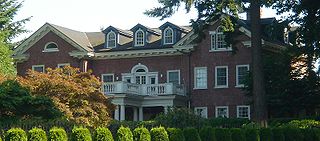
The Washington Governor's Mansion is the official residence of the governor of Washington. The Georgian-style mansion is located on the grounds of the State Capitol campus in the capital city Olympia. It is on the crest of Capitol Point, with a view of mountains, Capitol Lake and the city.
The 1965 Puget Sound earthquake occurred at 08:28 AM PDT on April 29 within the Puget Sound region of Washington state. It had a magnitude of 6.7 on the moment magnitude scale and a maximum perceived intensity of VIII (Severe) on the Mercalli intensity scale. It caused the deaths of seven people and about $12.5–28 million in damage. There were no recorded aftershocks.
Joseph Henry Wohleb (1887–1958) was an American architect from Washington.
Littlerock is an unincorporated community in Thurston County, Washington, United States. Littlerock is 11 miles (18 km) southwest of Olympia. The town is west of Interstate 5 and Maytown.
Norman J. Johnston was a Professor in the Departments of Architecture, Landscape Architecture, and Urban Planning in the University of Washington College of Built Environments.

The Du Pen Fountain is a water fountain at the former Washington State Library building on the Washington State Capitol campus in Olympia, Washington, in the United States. The sculptor, Everett Du Pen (1912–2005), was well known in the Northwest, and chairman of the Sculpture Department at the University of Washington when he was commissioned for the piece in 1955. The fountain is made of 900 pounds (410 kg) of copper-enriched bronze, green terrazzo, and cement. An element of the fountain is a pair of salmon spitting water. The fountain, along with the nearby and much larger Tivoli Fountain replica, is shut down by the state property administration agency during summer droughts. The artist also created the Fountain of Creation at the Seattle Center for the 1962 World's Fair. The Seattle fountain is also nicknamed Du Pen Fountain.

The Joel M. Pritchard Building at the Washington State Capitol campus in Olympia was built in 1957–1958 to house the Washington State Library, which had outgrown its previous location in the basement of the Washington Supreme Court's Temple of Justice. The building's architect, Paul Thiry who also designed the Century 21 Exposition complex in Seattle, used Modern design incorporating the Wilkeson sandstone quarried a few tens of miles away and used in the state capitol and other buildings. It was the last monumental building added to the capitol campus and one of the few departures from the Olmsted Brothers' 1928 campus plan. It was described as "among the most important regional archetypes of mid-century architectural design and thought...a textbook on how Washingtonians looked at the future in the 1950s". It was named for Joel M. Pritchard, a U.S. Congressman from Washington and the state's Lieutenant Governor. Thiry won the American Institute of Architects/American Library Association Library Building Award for the design, the first such award to be presented. The building was listed on the National Register of Historic Places in 2015.
The Washington State Library is a government agency that operates public libraries in Washington state's prisons and mental hospitals, and maintains collections related to the state government. Based in Tumwater, it is a service of the Washington Secretary of State and was founded in 1853 as the Washington Territorial Library. The library has a collection of 2.25 million physical items and other online resources available to residents of the state.
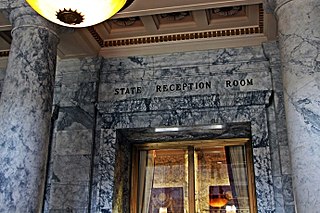
The State Reception Room is a formal salon on the third floor of the Washington State Capitol in which foreign dignitaries and other official visitors are presented to, and received by, the Governor of Washington. It is notable for having what was once the world's largest single-loom carpet.
















